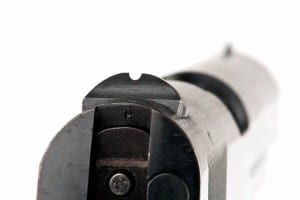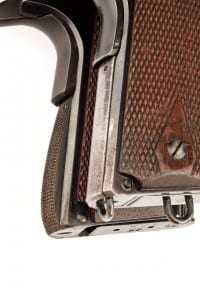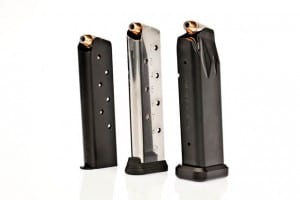Now that the celebratory hoopla surrounding the 1911’s 100th birthday is behind us, it’s time to take a hard look at what a century has done to the pistol. We have more options today than ever, but are modern variants that much better than the original?
By Rick Hacker
Sophocles, one of the great playwrights of ancient Greece, observed, “Success is dependent on effort.” This was certainly true in the case of the handgun that became known as Colt Automatic Pistol, Caliber .45, Model of 1911. The years, months and days leading up to its adoption as the official sidearm of the U.S. Army must have been stressful ones for John Moses Browning. He had spent 14 years developing this now-iconic pistol, from the issuance of his first “movable breech block” patent in 1897 until the government’s final report in 1911, attesting “…that the Colt Calibre .45 Automatic Pistol…be adopted for use by foot and mounted troops in the Military service in consequence to its marked superiority to the present service revolvers, and to any other known pistol…”
The Government 1911 ended up proving that, in addition to superior stopping power, it had superior staying power—not only to the P35, but to any other service sidearm yet invented. After manifesting itself during World War I to become, as Colt’s ads pointed out, “The Right Arm” of America’s doughboys, it found acceptance among law enforcement personnel and civilians alike, who enthusiastically adopted it for both self-defense and sport. Amazingly, there were absolutely no changes made to the gun—aside from exterior finishes, such as nickel plating and engraving—until 1924.
That year, the 1911 pistol got a few tweaks. Fittingly enough, it was Colt that made the changes. These included an arched mainspring housing to reposition the gun in the hand, a shorter trigger and wider hammer spur for better accessibility and control, a longer grip-safety spur to help curtail slide bite and much-needed improved sights. In addition, the original Carbona blue on military models was changed to a Parkerized finish. Thus emerged the 1911A1—the first “new” Model 1911 since its adoption by the Army 13 years earlier.
That started a trickle-down effect within the Colt factory, resulting in adjustable-sight target models such as the National Match and later the Gold Cup, and a few new chamberings like .38 Super and .22 LR, the latter in the Ace and Service Ace. But overall, it remained the same basic seven-shot, semi-automatic Colt 1911 that Gen. “Black Jack” Pershing and his mounted troopers strapped on when they galloped across the Mexican border in pursuit of Pancho Villa in 1916. Lest we forget, the 1911—for all its longevity and modern-day alterations—started out as a cavalry sidearm.

Perhaps the most functional change the 1911 has undergone in the past 101 years rides atop the slide. The original sight configuration was practically useless in low light, and acquiring a sight picture was akin to molasses in the wintertime.
Obviously, some felt they could improve upon Browning’s creation, even though it was deemed superior to “any other known pistol.” I suspect experimentation by both the skilled and unskilled began shortly after the first civilian “C” serial-numbered pistol was produced. One of the first recorded instances was during the 1920s and ’30s, when some Texas Rangers began deactivating the grip safeties of their 1911s by tying them back with rawhide. Today, that practice has morphed into Wayne Novak’s “The Answer,” a gunsmith-installed, one-piece aluminum mainspring housing that completely does away with the grip safety, which many consider a deterrent in combat.
New and Improved?
A lot more has happened to the 1911A1 since that time, involving both internal and external modifications by innovators such as Novak, Les Baer, Ed Brown, Richard Heinie and Bill Wilson, to name just a few. Companies like Kimber, Para USA, SIG Sauer, Springfield Armory, Smith & Wesson, Remington and most recently Ruger have each put their spin on the venerable warhorse. Even Colt now has no fewer than 24 variations of its 1911, not counting the company’s 100th anniversary limited editions.
My shooting preferences run the gamut from an original World War I 1911 all the way to a modern Kimber Super Match II, including a reblued (I didn’t do it) 1970s-era Colt Mark IV with gold etching (OK, I had that done), which some have gone so far as to call “garish.” And, of course, I’ve shot countless others, from commercial to customized guns. All of which got me thinking: Just how necessary are all the changes that have been made over the years to Browning’s wundergun? After all, did not he create perfection in the first place? Do we really need all these bells and whistles?
As if to answer my questions, last March Gunsite Academy held a 1911 Centennial 250 Pistol Class to commemorate the 100th anniversary of the adoption of the 1911. It was an all-inclusive 250 course—basically a week-long boot camp for defensive shooters. But, for this event, only 1911-type .45 ACP semi-automatics could be used. The 250 is an intensive class, in which each student burns 800 to 1,000 rounds of ammunition, runs through several types of drills, engages in night fire and is presented with hostage/bad-guy scenarios at ranges from 3 to 25 yards. This would prove to be the perfect five-day field test for me to verify, through practical live-fire experience, just what is hot and what is not as far as improvements made to the 1911.

Lowered and flared ejection ports are nearly standard equipment on modern 1911s, although during testing of the original configuration, 1,000 rounds were digested without a stoppage. The author saw similar results in a less-formal workout.
For my control gun, I went back to basics—the original 1911. However, not wanting to put my vintage World War I gun through the rigors of the Gunsite class, I selected the next best thing, the Colt Tier III 1911-1918 Commemorative. The commemorative is a reissue of the G.I. 1918 “Black Colt” and representative of the gun that had helped win the “War To End All Wars.”
At the opposite end of the spectrum, I selected a top-of-the-line target gun with an aluminum frame, the Kimber Super Match II, right out of the box. Finally, as a mid-point balance between these two, I included my 4-inch-barreled, stainless steel Springfield Armory Super Tuned Commander. Thus, I had three variants of the 1911 platform, spanning the years from 1911 to 2011. Hard use at Gunsite revealed some surprising things about each of them.
The Good, the Bad and the Beavertail
On one hand—literally your shooting hand—the extended beavertail is the best thing to happen to the 1911 since its invention. It mitigates that sharp pinch of pain and the sight of blood (yours) should you grip your gun too high as the slide moves during recoil. I started out firing the first few segments of the course with the replica Colt. It’s one thing to carefully position the gun in your hand at the range, but during the 250 course, you are usually in a timed draw-and-fire sequence from the holster, opting for speed and accuracy.
Less than 50 rounds into this exercise the web of my hand between the thumb and forefinger was becoming raw. To prevent further escalation of this issue, I applied tape over the area. Later, I switched to my Springfield Armory Super Tuned and Kimber Super Match, both of which sport beavertail grip safeties. But that presented another problem.
One of the exercises was the Failure Drill, a slightly misleading name because it has nothing to do with failure of the gun, but rather, failure of the first two bullets to stop your assailant, who may be beyond pain due to the influence of drugs and/or alcohol. It involves two shots to the body and a quick third shot to the head. The end goal at Gunsite is to accomplish all this within 2 seconds, starting from the holster.

When Colt modified the original 1911 to create the 1911A1 in 1924, it added an arched mainspring housing. Interestingly, many modern interpretations of the pistol have done away with this early “improvement.”
Consequently, on numerous occasions, speed-induced stress caused me to acquire an improper purchase on my gun, which found me on target and squeezing the trigger without the grip safety depressed. By the time I adjusted my grip and fired a shot, the target had turned and I was two bullets behind—maybe dead had it been a real-life situation. I saw this happen with numerous other students as well. Part of the problem is Gunsite teaches you to grasp the gun with your thumb riding high on the thumb safety, so it can be easily manipulated. This raises the gun hand’s grip and consequently often shifts pressure off the grip safety.
I didn’t encounter this problem on the indoor and outdoor simulators. However, in each scenario I was stalking targets with the gun already drawn and firmly secured in a two-handed combat hold.
Maybe those Texas Rangers had it right, because on the range I saw a number of shooters resorting to thick rubber bands to disengage their grip safeties. Another solution is a wider grip safety and a more dramatically arched beavertail, as originally designed by the late Charlie Kelsey. Beavertail grip safeties with extended pads are even better. Still, my failures to fire got me thinking about having Novak install “The Answer” on my Springfield Armory .45, a thought reinforced when I remembered that Gunsite’s founder, the late Col. Jeff Cooper, often disengaged grip safeties on his 1911s. As Cooper once pointed out, the grip safety was never part of Browning’s original 1911 design; the Army insisted he add it.
Seven, Eight, 13
One of the earliest readily available “improvements” for the 1911 came in 1988, when the then newly formed Para-Ordnance introduced a kit that enabled the 1911 to use a 13-round, double-stack .45 ACP magazine. It increased firepower by 86 percent—almost twice its original capacity. Two years later Para-Ordnance began manufacturing an entire pistol, which became the P14-45 and has since evolved into other models.
For shooters with small- or medium-size hands, 1911-style guns with double-stack magazines can be unwieldy. Plus, in my experience, double-stacks jam more than single-stacks. Moreover, the bulkier double-stacks are heavier and harder to manage for concealed-carry purposes.
My conclusion? Single-stack
1911s are better for self-defense. Interestingly, even Para USA now produces excellent single-stack models. That said, one of the greatest 1911 innovations is the eight-round magazine, which allows an extra round to be loaded without extending magazine length. I found this extra round to be an advantage at Gunsite, because it gave me a little breathing room when planning to execute a tactical reload.

The original 7+1 capacity has swollen, and magazine construction has improved. Today a double-stack .45 ACP 1911 can carry 14+1 rounds, and reloads are hastened with bumper pads.
Whatever your choice, don’t skimp on magazine quality. Buy the best. Most of the stoppages I observed were caused by inferior magazines. In addition to the Colt 1911 factory-blued magazines, I used stainless steel Chip McCormick and Kimber Kim-Pro Tac-Mags throughout the course and did not experience a single failure to feed with any of my handguns.
Arched Rival
I find it interesting the 1911 went from its original flat mainspring housing and long, smooth trigger to an arched housing and shorter, serrated trigger in the 1911A1. But, many manufacturers and competitive shooters are now taking a giant step backward and opting for the original configuration. Which is best?
The truth is, in this case there is no best—it is a personal choice. For me, the arched housing anchors the gun more firmly in my hands, but I also like the flat mainspring housing because it looks nostalgic. However, I prefer the longer trigger, because it gives me more control with my trigger finger.
Port of Contention
An almost universal feature on today’s 1911-style semi-automatics is the lowered and flared ejection port, and one wonders why Browning didn’t come up with this idea. Perhaps he realized it wasn’t really needed. After all, during the Army’s original rapid-fire tests, a trooper fired 1,000 rounds from a 1911 in 38 minutes without a single jam.
Firing both Black Hills and Hornady 230-grain ball ammo through my Colt 1911, I had zero malfunctions. The real culprit in smokestacked casings lies more with an improperly adjusted ejector or extractor, a weak magazine spring or the feed ramp—bullet configuration notwithstanding. Nonetheless, lowered and flared looks sexier than the original ejection port.
Setting Your Sights
Sights on the original 1911 left a lot to be desired. Although I managed to qualify with my issue 1911A1 in the Army, decades later my eyesight is much worse. At Gunsite, the anemic sights of the Colt 1911 didn’t help, and wearing polarizing sunglasses made the dark sights almost invisible against the target. I had to shoot with my regular glasses, which put more fatigue on my eyes from the bright Arizona sun. Needless to say, I was glad we were shooting for body mass hits and not bullseyes.
Today, manufacturers pay increased attention to giving their pistols sights that are more visible and serviceable. Wizards like Heinie and Novak have proved the rear sight should not be overlooked, and the addition of tritium—which wasn’t discovered until 1934, some 23 years after the 1911 was adopted for service—provides us with a new level of visibility in low light. The sights on modern 1911s are a definite improvement over the original versions.
Slide Rule
Along with flared ejection ports, forward slide serrations look cool, but in my opinion have little practical value. I’d put them on most of my 1911s if I could, even though I’d never use them. I simply don’t want my hand that close to the muzzle.
At the other end of the slide, I like the innovative and deep, easy-to-grasp patterns of some of the rear serrations one sees today. Besides adding to the pistol’s aesthetics, they represent a tactile improvement over the thin, vertical serrations on the original. In fact, I wonder why no one has created a slide for the 1911 with a slightly flared rear for ease of racking, such as on the Beretta 92.
The Weight is Over
Steel has been the metal of choice for the 1911 since, well, 1911. But in 1951 Colt changed all that with its aluminum-frame Commander (later renamed the Lightweight Commander). Recently others have followed suit, with Kimber practically single-handedly changing how shooters view aluminum-frame .45 ACPs.
There is, however, a certain cachet with having a steel 1911. At Gunsite I shot both, and the type of metal made no difference in function or accuracy. My aluminum-frame Kimber was noticeably lighter, even with its longer 5-inch barrel, but my stainless 4.25-inch barreled Springfield Armory .45 ACP absorbed recoil better.
As an aside, actor Tim Abell carried the same Colt Lightweight Commander throughout his tour of duty with the 2nd Battalion, 75th Ranger Regiment. Abell had convinced his commanding officers to let him carry the non-issue Commander because he had it since he was 14 and had enough confidence in it to stake his life.
At the end of the week, I left with more than swollen and bandaged hands from hurried slide manipulation, constant recoil and “tap, rack, bang” exercises. I had also acquired a greater appreciation and practical understanding of the gun Browning invented more than 100 years ago, and of the many enhancements it has inspired. I’m sure there are more to come.


